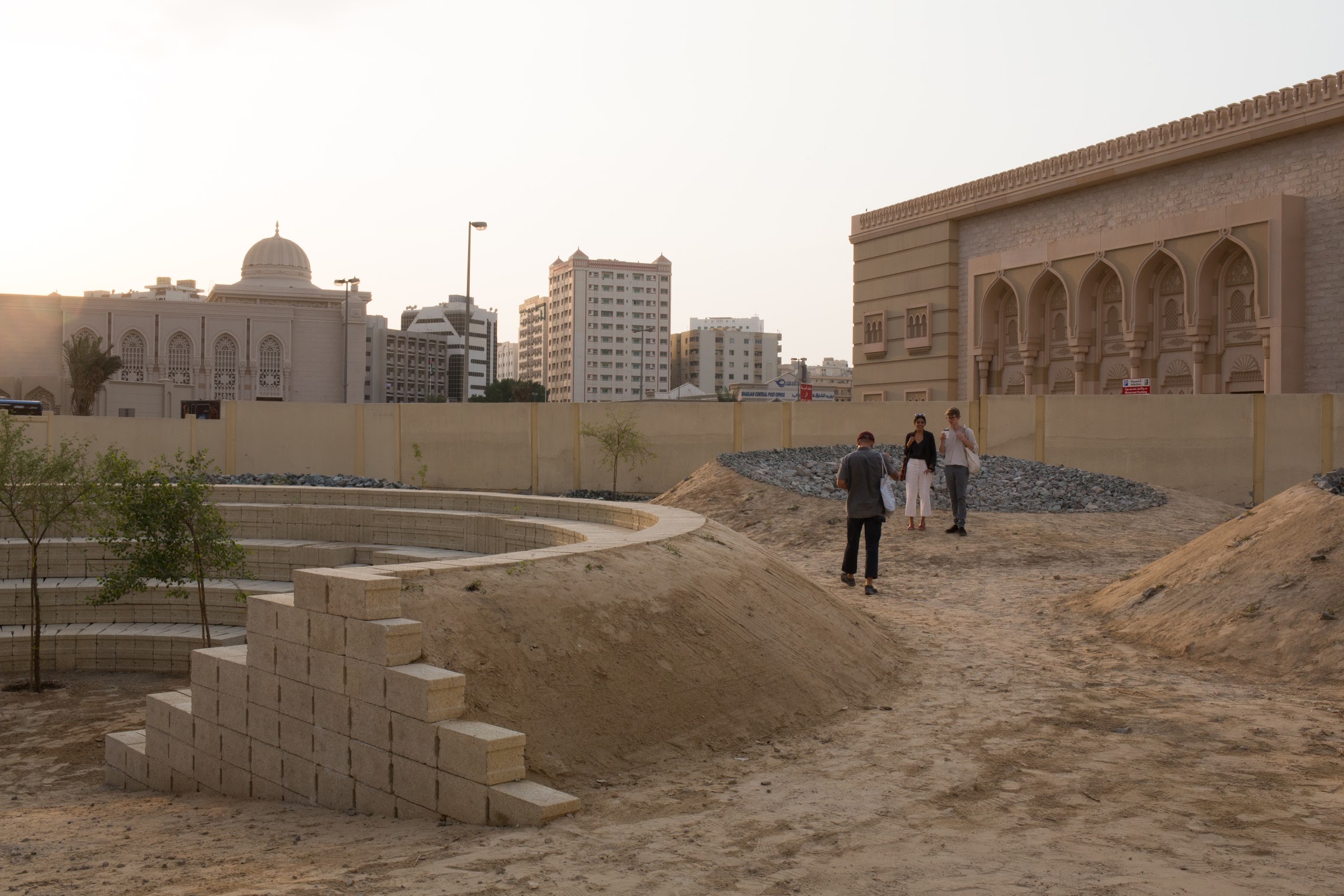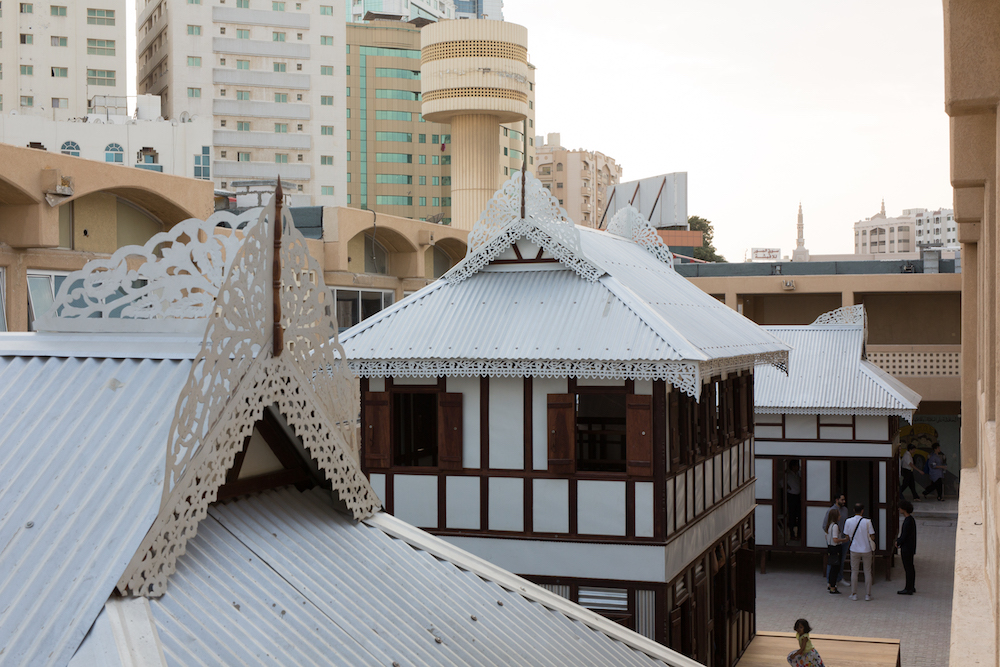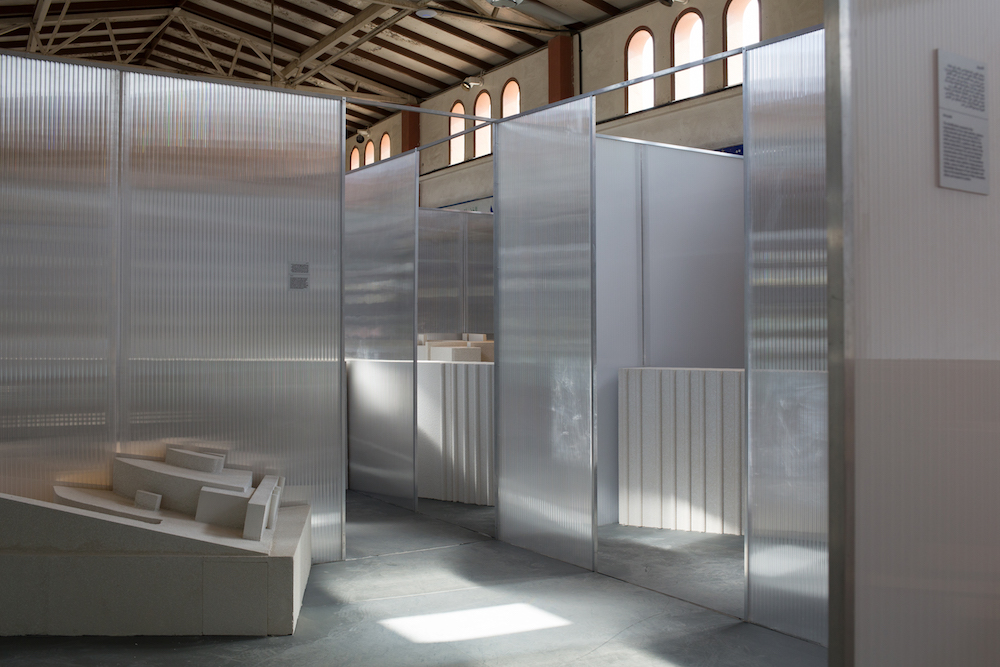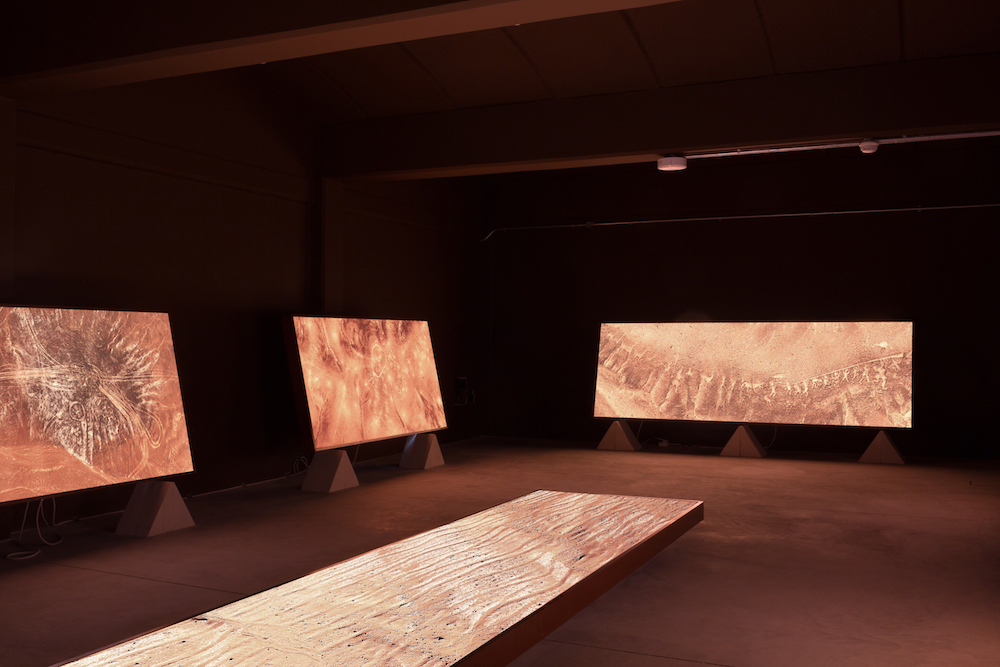
A full moon rises over the garden of the Al-Qasimiyah School in Sharjah, silhouetting nine sand bowls that rise from its lunar landscape. Coagulated with layers of rubble retained from the building’s recent renovation, this alien topography is an unlikely oasis for forty-odd desert plants, sheltering the foliage from the harsh Arabian sun. Although the building is now populated with dozens of architectural projects addressing topics of sustainability, reparation and care as part of the inaugural Sharjah Architecture Triennial, Becoming Xerophile by Cooking Sections is perhaps the most enchanting of them all.

A self-watering plant haven might seem like an odd fit for an architectural exhibition, but Rights of Future Generations—curated by Adrian Lahoud, the dean of architecture at the Royal College of Art—stakes its claim far outside the traditional boundaries of the ever-growing conglomerate of global architecture and design -iennials. Stand-out projects trace the political agency of enchantment within Chilean geoglyphs, decode the economies of wetness in Bangladesh and poetically explore the precarious rituals of maritime Sufi priests—and all of the triennial’s forty-odd participants take an interdisciplinary, cross-continental approach to architecture as a social, cultural and political device. The projects slip readily into the adjacent realms of art, science and anthropology to respond to issues of climate change, lingering colonial legacies and the violent use of architecture as a weapon of the state, rejecting the more literal, and indeed more restrictive, idea of what architecture is and what it can do.
“The projects slip readily into the adjacent realms of art, science and anthropology”
“We are not interested in imposing a static definition of rights, futures or generations upon all participants,” suggests Lahoud. “Nor are we presenting a concrete vision of the future as some shiny new building—it won’t be in that image, and that is our problem to reconcile with.” Though oriented toward the speculative future of the global south, the triennial is arguably more concerned with unpacking historical injustice and making reparations in the present to enable a more equitable future. “Could the future generation have a right to the present and, if so, who would protect those rights?”

Developed with the support of a board of trustees helmed by Hoor Al Qasimi—daughter of the Ruler of Sharjah, director of the Sharjah Art Biennial since 2003, founding director of the Sharjah Art Foundation and patron saint of the city’s growing contemporary art scene—alongside urban planning bodies and academic institutions, the triennial stakes a claim as one of the most site-specific and progressive architecture events to emerge in recent years. Although it is headlined by a roster of globally-renowned individual and collaborative practices—from Cooking Sections and members of Forensic Architecture to this year’s Turner Prize-nominated artist-investigator Lawrence Abu Hamdan, Columbia University’s GSAPP and even DJ Nicolas Jaar—it also serves as a valuable first exhibition gateway to younger experimental collectives like Feral Atlas and Saudi Arabian architecture practice Studio Bound.
That the Sharjah Triennial is an architectural exhibition rather than an art or design one is perhaps most apparent through its selection of venues. Rights of Future Generations anchors itself in a school, a market and Africa Hall—three primary site-specific buildings of local esteem. But the exhibition also bleeds into the urban fabric of Sharjah, with the installation of a newly permanent (and highly on-trend flushed coral toned) public square designed by Belgium-based practice Dogma, alongside performances across the city. In salvaging these venues, which were either doomed for a slow decay or rampant demolition, the triennial’s leaders think like architects and strategize like urban planners. Rather than relying on the same old space like the Venice Architecture Biennale’s Giardini and Arsenale, or a formal exhibition hall like Art Basel’s Messeplatz, the Sharjah Triennial activates the rich history of these old buildings, rebirthing them as stages for a global architecture event.

At the sinuous half-moon shaped old Al Jubail vegetable market, eight projects engage with a range of topics including cosmological agriculture, the falsification of heritage and dirt mounds. Dima Srouji’s project Depth Unknown—completed in collaboration with Dirar Kalash, Silvia Truini, Nadia Abu El-Haj and Omar Jabareen—subverts the sterile modernist grid of museum vitrines in order to reveal how archaeologists from Harvard, the British School of Archaeology in Jerusalem and the Israeli Civil Administration have selectively dug the ancient Palestinian city of Sebasti, with the suggestion that they have fabricated a false narrative of Israeli heritage. “Because it was forbidden to take photographs of the sites, we recorded audio that shows these archaeologists cease digging once they hit a certain layer mandated by the Isaeli government,” explains Srouji. “They dig to prove their own subjective narratives instead of uncovering the truth hidden in the ground.”
- Procession as part of Silences and Spectres of the Indian Ocean, Nidhi Mahajan’s commission for Rights of Future Generations, inaugural edition of the Sharjah Architecture Triennial. 2019. Photo courtesy of Talie Eigeland
Further down the curve is anthropologist Nidhi Mahajan’s Silences and Spectres of the Indian Ocean, an absorbing installation that details the mystical journey of the wooden boat or “dhow” across uncertain waters. It collages the global trade of goods with the transfer of faith, recreating Sufi shrines out at sea and on land that serve as spiritual anchors for sailors and their loved ones. For the grand opening of the triennial, a horde of sailors flooded the dimly-lit produce market with a model dhow, transforming the exhibition venue into a temporary day rave. Throughout the opening weekend, Sharjah overflowed with many such immersive performances, from a moving procession across the city led by the Cape Town-based singing group Al Ahly Thikr Jamaah, to an awakening ceremony of the awesomely psychedelic Ngurrara Canvas II (1997), a painting utilized by its forty Ngurrara artist-claimants at the 1997 National Native Title Tribunal as proof of their rightful ownership of a swath of Australian desert the size of Tasmania. They are powerful moments of collective experience that transcend the triennial’s dense exhibition text, which can, at times, feel like it’s been hit over the head with an e-flux glossary.
- Alonso Barros, Gonzalo Pimentel, Juan Gili and Mauricio Hidalgo, The Atacama Lines, 2019. Installation view. Commissioned by Rights of Future Generations, inaugural edition of the Sharjah Architecture Triennial, 2019. Photo by Antoine Espinasseau
The strategy of activating heritage to reshape the future and give agency to oppressed groups is a powerful theme that runs through many of the triennial’s featured projects. In the Al-Qasimiyah School, nautical murals of dolphins and tropical fish collide with Atacama Lines, a hypnotic visual atlas of geoglyphs carved into the deserts of northern Chile occupied by the Atacama tribe. During the opening of the triennial, the Atacama staged their own press conference in which they made a formal declaration of autonomy against the Chilean government. The tribe has successfully fended off attempts by both the military and mining companies to extend their reach into this arena of the desert on grounds of conservation of heritage. “It’s quite possibly the most powerful piece of public art,” reflects Lahoud. “In that it enables the survival of future generations.”
“The triennial is poised to bring much to its host city”
At the core of the inaugural Sharjah Architecture Triennial is the idea of recuperating “built” heritage to reshape the future—a strategy that spans across cultures and centuries, not least contemporary Sharjah. Al Qasimi salvaged the exhibition venues of the triennial through a series of land trades between powerful owners. “I’ve become known as the woman who saves buildings on Instagram,” Al Qasimi jokes. “When people want their local school or dilapidated movie theatre rescued from impending demolition, they’ll DM me.” Playing by its host city’s rules, the Sharjah Architecture Triennial is poised to save many more buildings from destruction within—and hopefully, in between—its future editions.

But as Sharjah destroys its own built heritage in rapid succession, razing many buildings less than a decade old as well as refashioning its own architectural history into a Disneyfied version of itself (the reconstruction of the “Historical Sharjah” city centre is an attempt to enhance the eighteenth- and nineteenth-century historical imaginary of the city. Meanwhile, the “Heart of Sharjah”, a five-step urban redevelopment scheme to be completed by 2025, stipulates the destruction of many structures including the iconic 1970s buildings lining Sharjah’s “Bank Street”—one of the most walkable areas of the city, according to Failed Architecture), the “rights” of this future are only good if they’re willed freely. In Sharjah’s race for global development, the Architecture Triennial could become a valuable source to address these local challenges on a global scale. The triennial is poised to bring much to its host city as it broadens the global conversation of architecture, control and censorship—providing its voice remains loud, clear and, most of all, free.









